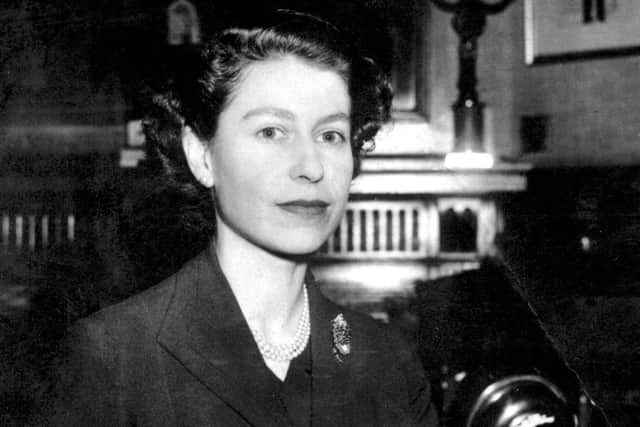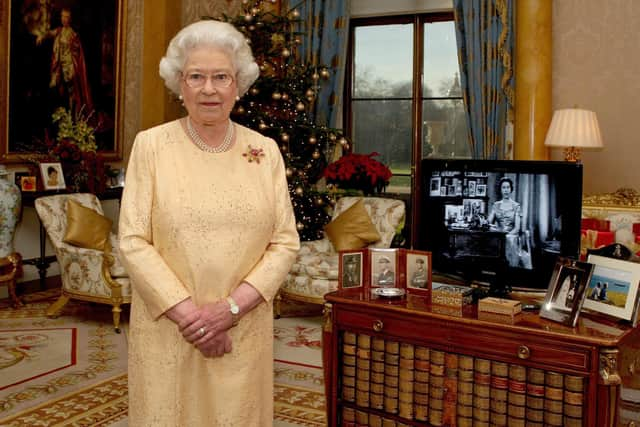The Queen’s Speech: Her Majesty’s most memorable addresses down the decades
Because of her long reign, the Queen has represented a constant in every living British subject and for many her annual message on Christmas Day comes with a reassuring familiarity.
Its formal title is ‘Her Majesty’s Most Gracious Speech’ and the idea itself came from Sir John Reith, founder of the BBC.
Advertisement
Hide AdAdvertisement
Hide AdThe first one in 1932 was given by the Queen’s grandfather King George V, meant to be simply to be a one-off event to inaugurate the BBC World Service but it became customary instead ever since 1939, as King George VI was keen to boost morale and reinforce belief in the common cause during World War Two.


Rudyard Kipling wrote the first one but the Queen writes all her ones herself though with some consultation. David Attenborough produced it for five years until 1991.
In 1956 she was criticised for “too many ponderous platitudes written into it by her officials”. Some still find the words somewhat bland and anodyne, especially as she is keen on the phrases “shining example”, “weak and innocent” and “the Commonwealth”.
Typically her speech reflects upon the major events of the year though she also mentions her own, and her family’s, personal milestones. Her connection and commitment to the Commonwealth is one of her abiding themes as she highlights the royals’ respective tours. Her religious values also shine through as she offers comfort to those suffering from a particularly tragic topical event.
Advertisement
Hide AdAdvertisement
Hide AdThe setting varies across the decades though usually the broadcast is filmed at Buckingham Palace a few days beforehand. Behind her is a decorated Christmas tree and selected family photo frames. Recently the photographs were delicately stage-managed to display only the major royals in an attempt to reassert their predominance in royal matters.


There have been a number of notable addresses marking different chapters of her reign. In 1956 the Duke of Edinburgh spoke from abroad while aboard the royal yacht Britannia. The Queen meanwhile made her speech from Sandringham. She said the Duke’s message gave her and her children the greatest joy and she wished him a good journey and admitted her sadness at being separated from him. She also showed sympathy to those who, unlike her, don’t enjoy a united family or can’t be at home for Christmas.
In 1957 and for the next 40 years, this broadcast was finally televised, apart from one year with the radio message of 1963 when she was pregnant with Prince Edward. The change occurred in part as a nod to modernity but also so that she would no longer “seem a rather remote figure to many”.
She remarked on the fact that her message could now be viewed in people’s homes. Some in Britain complained that their radio transmissions were affected by sunspots and so resulted in American police radio frequency interference. Listeners got to hear an American police officer say “Joe, I’m gonna grab a quick coffee.”
Advertisement
Hide AdAdvertisement
Hide AdApart from 1969 the Queen has broadcast her address every year. That year she decided to write it instead, supposedly because the Royals felt over publicised from the TV documentary Royal Family. “I want you all to know,” she wrote, “that my good wishes are no less warm and personal because they come to you in a different form.” But public concern prompted her to give an assurance there would be a return to tradition for 1970.


1980 was the year of the highest ratings to date, when a record 28 million viewers tuned into the BBC at 3pm. The message looked at the celebrations for the 80th birthday of The Queen Mother and addressed the notion of service in its many aspects.
In 1989 she read part of her speech from the stage in front of an audience at the Royal Albert Hall and it was the first time it had been heard prior to airing. She had previously recorded a message outdoors in 1975 from the gardens of Buckingham Palace.
1992, the 60th anniversary of the speech and the 40th of the Queen’s reign, was the year she described as ‘‘a horrible year’’ using the Latin phrase “annus horribilis”. It was when the marriages of Prince Charles and Prince Andrew fell apart as well as the eruption, a month before, of a large fire at Windsor Castle.
Advertisement
Hide AdAdvertisement
Hide AdWhen The Sun newspaper leaked the speech two days in advance, the Queen sued and the paper gave £200,000 to charity.


By 1997 the Palace had decided BBC and ITN would share it on alternate years (with Sky News added in 2011). They said it was to “reflect the composition of the television and radio industries today”. And it was a busy year for the Royals. The message began with images of Westminster Abbey, which had been the scene both of Diana’s funeral and the celebration of the Queen’s golden wedding anniversary, and she spoke of the joy of her married life. She also welcomed the devolution of power to Wales and Scotland and spoke of the benefits of being a United Kingdom.
In 2001, the Queen referred to the many tragedies of that year including the foot-and-mouth outbreak and the 9/11 attacks. There was the famous footage of the American national anthem being played for the Changing of the Guard at Buckingham Palace.
A year later was her 50th Christmas broadcast as she spoke about joy and sadness and reflected on her “personal loss” following the deaths of both her sister, Princess Margaret, and her mother. Beside her were positioned photographs of the Queen Mother, King George VI and Princess Margaret.
Advertisement
Hide AdAdvertisement
Hide AdIn the 2004 speech, footage included the Queen and the Duke of Edinburgh visiting a Sikh temple and Prince Charles attending various multicultural meetings as well as a Muslim school in east London. The theme of the message (“cultural and religious diversity and the benefits of tolerance”) was warmly received by leaders of Muslim and Sikh communities.
In 2012 Sky News broadcast the message in 3D. The Palace said: “We wanted to do something a bit different and special in this Jubilee year, so doing it for the first time in 3D seemed a good thing, technology wise, to do.” The Queen famously donned a pair of 3D glasses, as opposed to her usual rimless spectacles. This message was her 60th and commemorated her Diamond Jubilee as well 80 years of Christmas messages.
Four years later she said: “On our own, we cannot end wars or wipe out injustice, but the cumulative impact of thousands of small acts of goodness can be bigger than we imagine.”


There’s been a conscious effort to allow modernity to play its part in her presentation. The royals are, after all, acutely sensitive to avoid falling out of step with the society they lead. Will the message last or is it something that’s dying with the younger generations?
Advertisement
Hide AdAdvertisement
Hide AdBy all accounts, just as with other Christmas traditions this annual event may alter its priorities but it will endure.
Obviously, the Queen’s own mortality brings into question the status of the Commonwealth, a strong cog in the annual speech and to which her commitment has prolonged the health of the organisation.
What’s coming up this Christmas? Covid certainly. A clip of Captain Tom most likely. A reference to Brexit perhaps. Tune in at 3pm tomorrow.
Timing allows for global audience
Every year on Christmas Day, at 3pm, millions of us around the country tune in to watch the Queen’s Christmas message. It will be the 64th year since her first speech was broadcast on television in 1957, complete with sound and pictures that took an additional five years to put into effect.
Advertisement
Hide AdAdvertisement
Hide AdIt’s broadcast at 3pm to allow all 52 member-states of the Commonwealth to have a fair chance to listen in or to watch. So in New Zealand they get it at 6:50pm, in Australia at 7:20pm and in Canada at midday (all at their respective times).
This year is rather different in that the Queen has already twice broken the strict and traditional silence she has maintained with the media, First in April she issued a rallying call to the nation over the Covid crisis and evoked Dame Vera Lynn with her immortal line “We will meet again”. Then in May she delivered a second address to commemorate VE Day with its “Never give up” message while the United Kingdom remained under lockdown.
Support The Yorkshire Post and become a subscriber today. Your subscription will help us to continue to bring quality news to the people of Yorkshire. In return, you’ll see fewer ads on site, get free access to our app and receive exclusive members-only offers. Click here to subscribe.
Comment Guidelines
National World encourages reader discussion on our stories. User feedback, insights and back-and-forth exchanges add a rich layer of context to reporting. Please review our Community Guidelines before commenting.